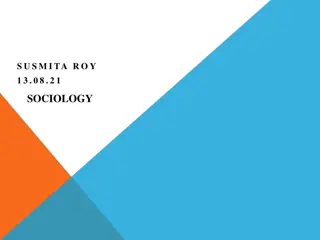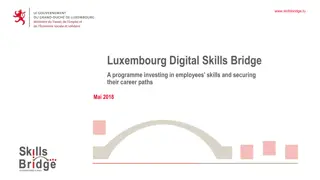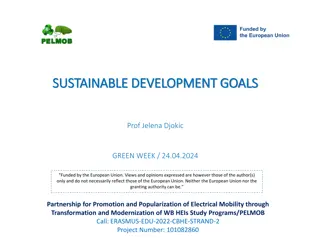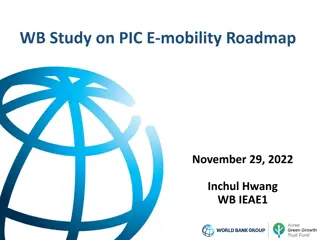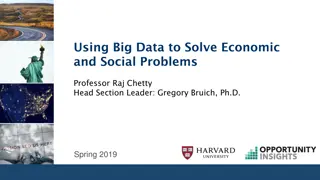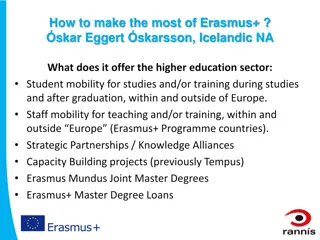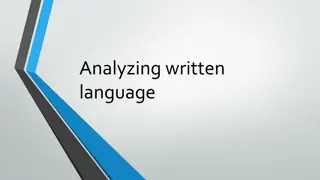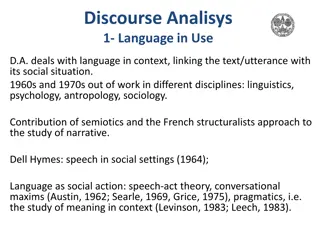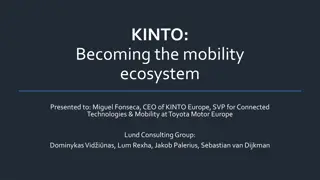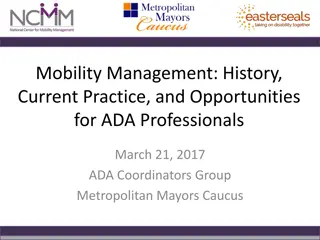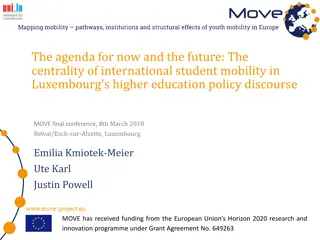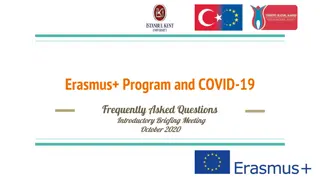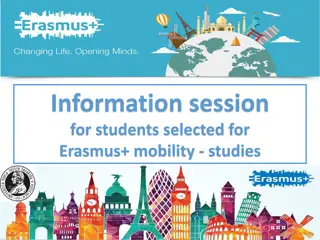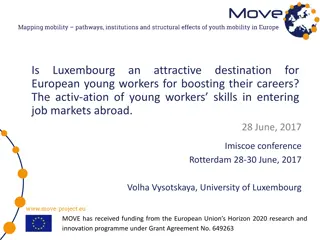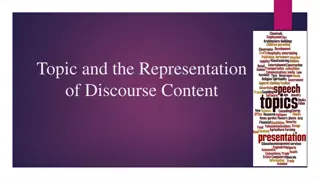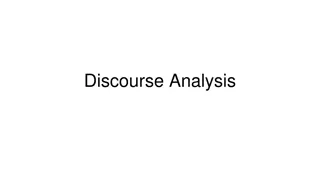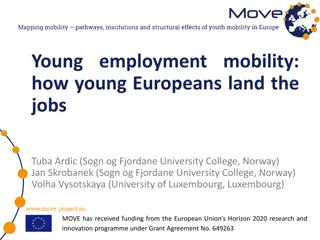The Role of International Student Mobility in Luxembourg's Higher Education Policy Discourse
The research discusses the centrality of international student mobility in Luxembourg's higher education policy discourse, emphasizing key aspects such as the analysis of student mobility, future vision, labor market dynamics, and geographic embeddedness. It delves into the factors influencing international student mobility, the role of the state in financing higher education, and the unique characteristics of Luxembourg's hyperdiverse and multilingual society.
Download Presentation

Please find below an Image/Link to download the presentation.
The content on the website is provided AS IS for your information and personal use only. It may not be sold, licensed, or shared on other websites without obtaining consent from the author. Download presentation by click this link. If you encounter any issues during the download, it is possible that the publisher has removed the file from their server.
E N D
Presentation Transcript
Designing the (Most) Mobile University: The Centrality of International Student Mobility in Luxembourg s Higher Education Policy Discourse SRHE conference, 6 December 2018 Newport Emilia Kmiotek-Meier Ute Karl Justin Powell University of Luxembourg
Overview I. II. III. IV. International student mobility Higher education in Luxembourg Analysis Results Future vision / Labour market Elites / sovereignty Geographic embeddedness Discussion I. II. III. V.
Student mobility student mobility degree mobility credit mobility part of programme abroad complete programme abroad Degree / the EU rather credit mobility (ERASMUS) Analysed as part of individual decision-making (Raghuram 2013: 143) Main lenses: factors influencing ISM (migration theories), students experiences, students employability (social inequalities, knowledge flows, social capital, mobility capital) Role of broader frames? Family? Institutions? State?
Student mobility & the role of state Filling in the gaps in financing higher education (Findlay, 2011 ) Neo-liberal rationale in competing for the best and brightest to satisfy labour market needs Host country s soft power -> Economically driven interests in hosting international students (Bolsmann and Miller, 2009)
Luxembourg Luxembourg s labour market (Graf and Gardin, 2018): highly paid jobs that have (among the most attractive in Europe) extraordinarily internationalised 160,000 cross-border workers per day commuting from France, Belgium, and Germany Luxemburgish society: hyperdiverse and multilingual society Source: freeworldmaps.net
Student mobility from Luxembourg 2003 foundation of the University of Luxembourg Degree mobility from Luxembourg 75-80 % of all enrolled in tertiary education study abroad mainly DE, FR, BE (language and geographical proximity) Credit mobility from Luxembourg an obligatory semester abroad for undergraduates mainly other EU-countries Almost 100% student mobility from Luxembourg
Students UL degree ISM towards Luxembourg UL students (WS 2016/2017), in % 70 60 58 57 50 49 40 35 30 29 26 25 20 14 10 7 0 Bachelor (N=3007) Master (N=1525) PhD (N=637) Lux EU non EU N=6,153 Source: UL (2016) 9
ISM in Luxembourg UL the most international university in the world number one in the Times World University Ranking 2018: international outlook Emphasis on the importance of student degree outgoing mobility especially for Luxembourgish industry returning students bring not only knowledge and knowhow but also their networks from abroad (Rohstock and Schreiber, 2012 ) 10
III Most international? Yes. but why? 11
Data No systematically integrated policy at the national level relating to outgoing or incoming student mobility in Luxembourg BUT Debates prior to the establishment of the UL in 2002/2003 in written form 14 pieces of writing, i.a. Bill on Foundation of the University of Luxembourg Opinion of Chamber for civil servants and public employees, Report of Commission of the higher education, research and culture 12
Methods Leaned on grounded theory methodology (Charmaz 2014) 1. Thematic coding searching for all sequences dealing with student mobility (credit/degree and outgoing/incoming). 2. In-depth analysis of selected extracts of the documents 3. Development of more theoretical concepts, i.e. the three lines of argumentation 13
IV Results 14
The future (vision) of the Luxembourgish society (I) Key concepts: knowledge society future development of the country innovation international competition and labour force Development of Luxembourgish society and economy within European and global contexts Investment in higher education: a step towards diversification of the economy [i]nvestment in higher education is commonly considered a means to achieve innovation, increased productivity and enhanced national competitiveness (Urbanovic and Wilkins, 2013, 374) 15
The the current state of the Luxembourgish society (I) Key concepts: elites sovereignty The initiative of the UL s foundation questioned the strategy to build up the country s elites AND development of young adults Additionally, and it has always been the argument put forward first, that the young were forced to leave their village to organise themselves in an unknown and much broader milieu, and to measure themselves with colleagues from all horizons (Opinion of Chamber of private employees) 16
The the current state of the Luxembourgish society (II) Outgoing mobility as a tool to foster the internationally competitive knowledge society: Study abroad -> new insights and international networks Return to Luxembourg -> contribution to the economic and social development Soft power receiving countries may have on Luxembourgish elites (Haugen, 2013) 17
The territorial areas of internationalisation of the UL Greater Region Existing links: the biggest group in the labour force in Luxembourg is that of cross-border employees and workers from the Greater Region (Brosius et al. 2014) Competition for degree students Implementation level occurs rather regionally The EU and Europe Country at the heart of the EU, model university 18
V Discussion 19
Only Luxembourg? Small and wealthy Luxembourg, but lacking the opportunities of a fully-developed and differentiated tertiary education system Taking advantage of the higher education infrastructure of other countries ISM from less wealthy or less developed countries to more developed countries (Woldegiorgis and Doevenspeck 2015; Bal and Williams 2004) 20
Economic imperative? The UL s foundation - a strategic step for improving Luxembourg s position within the global competition for the best and brightest international students are (..) prospective skilled workers in the globalising competition for talent (Mosneaga and Winther 2013: 181) Long-term perspective: Different than in many other countries We want it all! Degree outgoing & incoming / credit outgoing Credit incoming ? To secure innovation, Luxembourg needs both incoming and outgoing mobility of talented students 21
References (I) Balaz, V. and Williams, A.M. (2004) Been There, Done That : International Student Migration and Human Capital Transfers from the UK to Slovakia , Population, Space and Place 10(3): 217 237. Bolsmann, C. and Miller, H. (2009) International Student Recruitment to Universities in England: Discourse, Rationales and Globalisation , Globalisation, Societies and Education 6(1): 75 88. Brosius, J., Ray, J.-C., Verheyden, B. and Williams, D.R. (2014) Wage Differentials Between Natives and Cross-Border Workers Within and Across Establishments. Esch-sur-Alzette, Luxembourg: Luxemburg Institute of Socio-Economic Research (LISER). Working Paper Series no. 2014-04. Charmaz, K.C. (2014) Constructing Grounded Theory, London: SAGE. Findlay, A.M. (2011) An Assessment of Supply and Demand-Side Theorizations of International Student Mobility , International Migration 49(2): 162 189. Graf, L. and Gardin, M. (2018) Transnational Skills Development in Post-industrial Knowledge Economies: The Case of Luxembourg and the Greater Region , Journal of Education and Work 31(1): 1 15. Haugen, H. . (2013) China s Recruitment of African University Students: Policy Efficacy and Unintended Outcomes , Globalisation, Societies and Education 11(3): 315 334. 22
References (II) Kmiotek-Meier, E.A., Karl, U. and Powell, J.J.W (2018) Designing the (Most) Mobile University: The Centrality of International Student Mobility in Luxembourg s Higher Education Policy Discourse , Higher Education Policy (2018), 31(online first), 1-24. Mosneaga, A. and Winther, L. (2013). Emerging Talents? International Students Before and After Their Career Start in Denmark , Population, Space and Place 19(2): 181 195. Raghuram, P. (2013) Theorising the Spaces of Student Migration , Population, Space and Place 19(2): 138 154. Rohstock, A. and Schreiber, C. (2012) The Grand Duchy on the Grand Tour: A Historical Study of Student Migration in Luxembourg , Paedagogica Historica 49(2): 174 193. UL (2016) Key Performance Indicators, https://wwwen.uni.lu/university/official_documents, accessed 13 February 2018. Urbanovic , J. and Wilkins, S. (2013) Internationalisation as a Strategy to Improve the Quality of Higher Education in Small States: Stakeholder Perspectives in Lithuania , Higher Education Policy 26(3): 373 396. Woldegiorgis, E.T. and Doevenspeck, M. (2015) Current Trends, Challenges and Prospects of Student Mobility in the African Higher Education Landscape , International Journal of Higher Education 4(2): 105 115. 23
Thank you for your attention! Contact: Emilia Kmiotek-Meier emilia.kmiotek@uni.lu University of Luxembourg Facult des Lettres, des Sciences Humaines, des Arts et des Sciences de l'Education Institute of Geography and Spatial Planning http://www.move-project.eu The research from the MOVE project leading to these results has received funding from Horizon 2020 under Grant Agreement N 649263. 24



